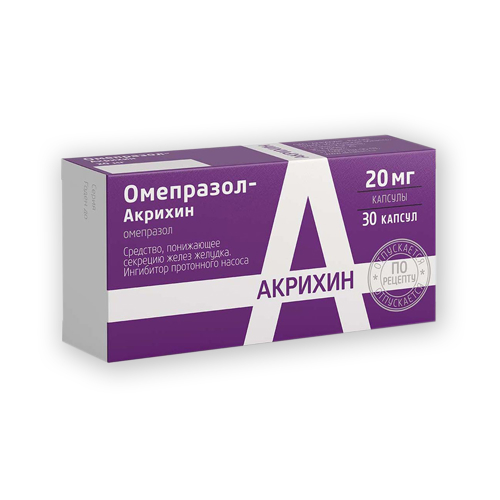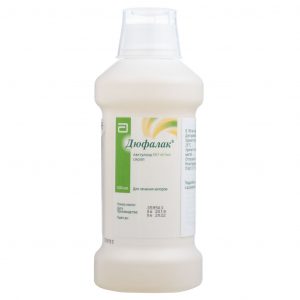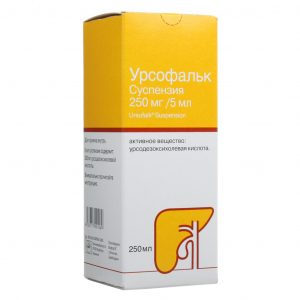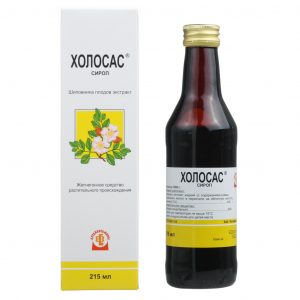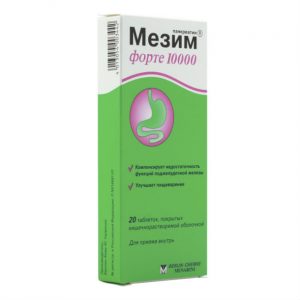Description
Latin name
Omeprazole
Release form
Capsules.
packaging 30 pcs
Pharmacological action
Omeprazole – proton inhibitory pump, antiulcer.
Pharmacodynamics
Omeprazole inhibits the enzyme H + – K + -ATPase (“proton pump”) in the parietal cells of the stomach and thereby blocks the final stage of hydrochloric acid synthesis. This leads to a decrease in the level of basal and stimulated secretion, regardless of the nature of the stimulus. After a single oral administration, the action of omeprazole occurs within the first hour and lasts for 24 hours, the maximum effect is achieved after 2 hours. In patients with peptic ulcer of the duodenum, taking 20 mg of omeprazole maintains an intragastric pH = 3 for 17 hours. secretory activity of the drug is fully restored after 3-5 days.
Pharmacokinetics
Omeprazole is rapidly absorbed from the gastrointestinal tract, Cmax in plasma is reached after 0.5 1 hours. Bioavailability is 30 40%. Plasma protein binding is about 90%. Omeprazole is almost completely metabolized in the liver. T1 / 2 – 0.5 1 hours. It is excreted mainly by the kidneys in the form of metabolites. In chronic renal failure, excretion decreases in proportion to a decrease in creatinine clearance. In elderly patients, excretion decreases, bioavailability increases. With liver failure, bioavailability is 100%, T1 / 2 – 3 hours.
Indications
peptic ulcer of the stomach and duodenum
reflux esophagitis
erosive-ulcerative lesions of the stomach and duodenum associated with NSAIDs
stress ulcers of the ulcer
Zollinger-Ellison syndrome.
contraindication srd
Use during pregnancy and lactation
Contraindicated during pregnancy and lactation.
Dosage and administration
Inside, with a small amount of water (do not chew the contents of the capsule).
Peptic ulcer of the duodenum in the exacerbation phase – 1 capsule (20 mg) per day for 2-4 weeks (in resistant cases – up to 2 capsules per day).
Peptic ulcer in the exacerbation phase and erosive-ulcerative esophagitis – 1-2 capsules per day for 4-8 weeks.
Erosive and ulcerative lesions of the gastrointestinal tract caused by NSAIDs – 1 capsule per day for 4-8 weeks.
Eradication of Helicobacter pylori – 1 capsule 2 times a day for 7 days in combination with antibacterial agents.
Anti-relapse treatment of peptic ulcer of the stomach and duodenum – 1 capsule per day.
Anti-relapse treatment of reflux esophagitis – 1 capsule per day for a long time (up to 6 months).
Zollinger-Ellison syndrome – the dose is selected individually depending on the initial level of gastric secretion, usually starting at 60 mg / day. If necessary, the dose is increased to 80-120 mg / day, in this case it is divided into 2 doses.
Side effects of
From the digestive system: diarrhea or constipation, nausea, vomiting, flatulence, abdominal pain, dry mouth, taste disturbances, stomatitis, transient increase in plasma liver enzymes in patients with a previous severe liver disease – hepatitis ( including with jaundice), impaired liver function.
From the nervous system: headache, dizziness, agitation, drowsiness, insomnia, paresthesia, depression, hallucinations in patients with severe concomitant somatic diseases, in patients with previous severe liver disease – encephalopathy.
From the musculoskeletal system: muscle weakness, myalgia, arthralgia.
From the hemopoietic system: leukopenia, thrombocytopenia in some cases – agranulocytosis, pancytopenia.
From the skin: itching rarely (in some cases) – photosensitivity, erythema multiforme, alopecia.
Allergic reactions: urticaria, angioedema, bronchospasm, interstitial nephritis and anaphylactic shock.
Other: visual impairment, peripheral edema, increased sweating, fever, gynecomastia rarely – the formation of gastric glandular cysts during prolonged treatment (a consequence of inhibition of hydrochloric acid secretion, is benign reversible).
Drug Interaction
Long-term administration of omeprazole 20 mg once daily in combination with caffeine, theophylline, piroxicam, diclofenac, naproxen, Metoprolol, propranolol, ethanol, cyclosporine, lidocaine, quinidine and estradiol did not change their plasma concentrations.
No interaction with concurrent antacids was noted.
Changes the bioavailability of any drug whose absorption depends on the pH (eg iron salts).
Overdose
Symptoms: impaired vision, drowsiness, agitation, confusion, headache, increased sweating, dry mouth, nausea, arrhythmia.
Treatment: symptomatic. There is no specific antidote. Hemodialysis is not effective enough.
Storage conditions
Dry, protected from light, at a temperature below 25 ° C.
Expiration
2 years.
Deystvuyuschee substance omeprazole
Dosage form
Dosage form
capsules
